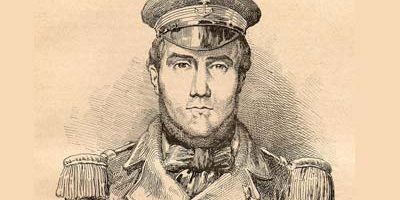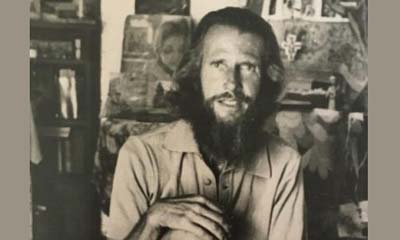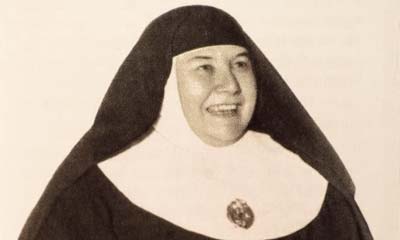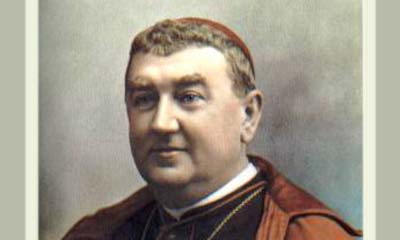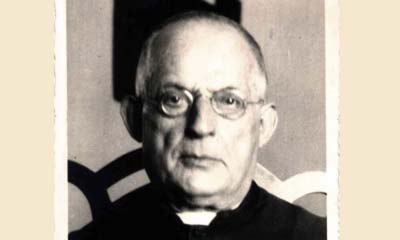January 31, 2024
Captain Auguste Marceau
Dear Friends,
“All things are Christian, all are Catholic on L’Arche d’Alliance” (a ship serving the missions to Oceania), an eyewitness once wrote. “On the bow is the statue of the Virgin of Seven Sorrows; at the rear of the room is the image of Our Lady of Hope, and the pavilion bears the Cross! What order, what tranquility among the crew!… Here, nothing in sight could fail to edify; no arguing, no swearing, and even no commotion; maneuvering proceeds peaceably, and you feel as quiet in your cabin as you would in a convent cell. And what shall I say about the worthy captain, Monsieur Marceau? Every day, he attends Holy Mass and receives Holy Communion. Every day, he does his two meditations, and be the weather favorable or unfavorable for navigation, he invariably shows the same gentleness and affability” (Letter from the Marist missionary Xavier Montrouzier to his Jesuit brother Henri, July 19, 1847). So who was this extraordinary sailor?
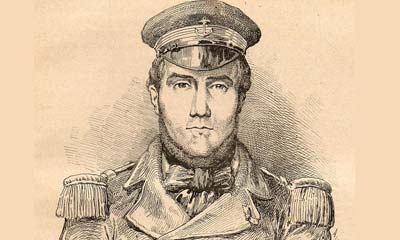 Auguste-François Marceau was born on March 1, 1806 in Châteaudun, south of Chartres (France). His father, Nicolas-Séverin Marceau, served as the town’s sub-prefect, while his mother, Marie-Thérèse de Carvoisin, was from an old noble family. He was baptized when he was two months old, but he was not raised in the Christian faith. He was admitted to the École Polytechnique at the age of eighteen, and there discovered Saint-Simonism. The doctrine of Claude-Henry de Saint-Simon (1760-1825) proposed to transform society and establish human happiness through industry; it claimed that economic development would go hand in hand with moral and intellectual progress. Saint-Simon wanted to replace the abstract idea of God with the “universal law of gravitation” and to found a religion of science. The young man’s interest in social issues developed under the influence of the Saint-Simonians, but from a sectarian, anti-clerical perspective; he was also full of pride because of his brilliant intelligence and strong character. He devoted himself to the detailed study of the steam engine, and became a specialist in the field. On graduating from Polytechnique, despite having no particular attraction for the sea, he chose to join the navy.
Auguste-François Marceau was born on March 1, 1806 in Châteaudun, south of Chartres (France). His father, Nicolas-Séverin Marceau, served as the town’s sub-prefect, while his mother, Marie-Thérèse de Carvoisin, was from an old noble family. He was baptized when he was two months old, but he was not raised in the Christian faith. He was admitted to the École Polytechnique at the age of eighteen, and there discovered Saint-Simonism. The doctrine of Claude-Henry de Saint-Simon (1760-1825) proposed to transform society and establish human happiness through industry; it claimed that economic development would go hand in hand with moral and intellectual progress. Saint-Simon wanted to replace the abstract idea of God with the “universal law of gravitation” and to found a religion of science. The young man’s interest in social issues developed under the influence of the Saint-Simonians, but from a sectarian, anti-clerical perspective; he was also full of pride because of his brilliant intelligence and strong character. He devoted himself to the detailed study of the steam engine, and became a specialist in the field. On graduating from Polytechnique, despite having no particular attraction for the sea, he chose to join the navy.
In October 1826, Auguste set sail on a lengthy military cruise around the world aboard the corvette La Bayonnaise… In 1829, he took part in the Madagascar campaign, rescuing a company of sailors who had been caught in an ambush; this earned him the “Légion d’Honneur” at the age of twenty-three. In 1832, he embarked on an expedition to North Africa on La Robure, before moving on to the Sphynx, the first deep-sea steamship, whose functioning he improved. He was part of the scientific expedition that brought the Luxor obelisk to Paris; it was a gift to France from the Viceroy of Egypt, and was erected on the Place de la Concorde in Paris in 1836. In 1835, he took part in the Senegal campaign, as commander of the steam-powered escort ship L’Africain, where he was pleased to observe his mastery of the ship’s technology and of the handling of his crew. Unfortunately, he fell ill with malaria, and when he was brought back to Brest, he was on the brink of death. A pious cousin opened her home to him in Le Mans and gave him the best of care. She placed a medal of the Blessed Virgin at his bedside, and asked the confraternity of the Immaculate Heart of Mary, which had been founded that same year by Fr Desgenettes, the parish priest of Notre-Dame-des-Victoires in Paris, to pray for him. Six months later, thanks to quinine and the diligent care he had received, Auguste recovered. His cousin gave him the medal of the Virgin Mary, which he carelessly tossed aside among his belongings.
Auguste was soon put in charge of the mail steamer Le Minos. He improved the efficiency of her boilers, which in turn increased the ship’s speed. It was thanks to his excellent reactions that he saved the ship from an explosion that would otherwise have occurred through the negligence of a deckhand. Marceau was demanding and punctual in his duties, and an excellent naval officer, yet he was poorly rated because of his somewhat arrogant attitude towards his superiors, all the more so because he was far more knowledgeable about steam engines than most of the people he addressed. When not on duty, he frivolously indulged in a promiscuous, worldly lifestyle, and was prone to blasphemy. Yet he retained a form of honesty, and a desire to know the truth.
The Truth of Faith
In 1838, he joined the Mediterranean squadron at Toulon. He was assigned the steamer Le Vautour, whose task it was to monitor the Algerian coast. Despite the misgivings and criticism of his colleagues, he made a number of technical improvements to the vessel. From 1840 onwards, the conversion of several sailors for whom he had a high regard aroused in him a certain interest in the Catholic religion, even though he was inclined, at first, to scoff and sneer at them. He also noted that one of his officers often visited the sick. He was intrigued to see that his men showed this officer particular respect. He knew him to be a devout Catholic: “And yet,” he thought, “he is a man of great intelligence…” At the suggestion of a friend, he began to study the Catholic religion and discovered faith in the resurrection, and this sustained him when one of his nephews died. He was advised to read an apologetic book, Le Christ devant le siècle, written by a contemporary Catholic author. Already in the preface, he was drawn by the promise of a demonstration of the veracity of the faith.
Apologetics is the study of the rational foundations of the Christian faith. “Always be ready to give an explanation to anyone who asks you for a reason for your hope, but do it with gentleness and reverence”, exhorted St Peter (1 Pt 3:15). Far from ignoring each other, “Faith and reason are like two wings on which the human spirit rises to the contemplation of truth; and God has placed in the human heart a desire to know the truth—in a word, to know Himself—so that, by knowing and loving God, men and women may also come to the fullness of truth about themselves” (John Paul II, encyclical Fides et ratio, September 14, 1998, no. 1). This is why the Pope wrote: “I ask everyone to look more deeply at man, whom Christ has saved in the mystery of his love, and at the human being’s unceasing search for truth and meaning. Different philosophical systems have lured people into believing that they are their own absolute master, able to decide their own destiny and future in complete autonomy, trusting only in themselves and their own powers. But this can never be the grandeur of the human being, who can find fulfillment only in choosing to enter the truth, to make a home under the shade of Wisdom and dwell there. Only within this horizon of truth will people understand their freedom in its fullness and their call to know and love God as the supreme realization of their true self” (Fides et ratio, no. 107).
Marceau began to realize that philosophy, especially that which denies the existence of God, cannot suffice to ensure the happiness of mankind. He would occasionally meet with a priest in Toulon. From one book to the next, and from conversation to conversation with Christian friends, he became intellectually convinced of the truth of the faith, but did not let it enter into his life: his pride and his way of life still formed an obstacle to his conversion. Seeing this, someone advised him to pray. Since he knew no prayers, not even the Our Father or the Hail Mary, he secretly borrowed his maid’s prayer book. He also began frequently to make the Sign of the Cross. In July 1841, he confessed to Abbé Morin, the Navy chaplain in Toulon. When the time came to receive the Eucharist, he was assailed by a powerful temptation to doubt the reality of the Sacred Host: “Do I believe in the real presence of Christ?” Dismissing the temptation with scorn, he made no reply, but after Communion complained to the Blessed Virgin that he was not feeling more devotion. Then suddenly his heart was dilated and his eyes were flooded with tears. He was thirty-five years old. He told one of his friends, an officer like himself, who had questioned him about his conversion: “I did what you told me: I read, I prayed, and God did the rest!”
In a Drawer
This is when Auguste Marceau remembered the medal of Notre-Dame-des-Victoires that his cousin had given him on his return from Senegal, when he had been so close to death. By chance, he found it in a drawer, hung it on the chain of his pocket watch, and got in touch with Fr Desgenettes. He used to attend the Father’s church when he was in Paris, and joined the Marian Confraternity. His trust in Mary became so great that from that time on, all his seafaring expeditions were placed under the protection of Our Lady.
Early in 1842, in Nantes, Marceau met the venerable Léon Papin-Dupont (1797-1876), known as the “holy man of Tours”: this apostle of devotion to the Holy Face of Jesus and of Eucharistic adoration was also filled with zeal for charitable work. Their encounter marked the beginning of a spiritual friendship that was to express itself in a long and fruitful correspondence. The focus of their letters was on God, but they also shared their love of Marian and social works, and their attachment to Eucharistic adoration for the conversion of sinners. Auguste was transformed under Papin-Dupont’s influence, and displayed great humility. He began to seek out people with whom he could have spiritual conversations. The style of his letters, which before his conversion had been dry and conventional, changed deeply. They now breathed affection and tenderness. His own mother was one of the first people the officer endeavored to do good to, and she converted under his influence.
Auguste was criticized for making too public a display of his faith, for example by taking part in a Corpus Christi procession in uniform, candle in hand. He retorted: “I was a public unbeliever and, alas, an all-too eloquent apostle of lies; nothing could be more just than to repair this scandal I inflicted on society…” His past had made him sensitive to the notion of reparation and atonement, especially with regard to prayers to make amends for blasphemy. He understood that “Every offense committed against justice and truth entails the duty of reparation, even if its author has been forgiven” (Catechism of the Catholic Church, no. 2487).
Auguste started to read the lives of the Saints. From St Ignatius of Loyola, he picked up a maxim that he applied to himself: “One heroic act of self-abnegation is more pleasing to the Almighty than many other good works that others do following their natural inclinations.” He often meditated on the Four Last Things. He was also deeply moved by the reality of Purgatory, a mark of Divine Mercy that gives the faithful who have died in God’s grace the means to purify themselves of the residues of their sins. A year after his conversion, he made a retreat at the Trappist abbey of La Meilleraye. He felt drawn to the monastic life, but discerned that God wanted him in the navy.
In July 1842, under the July Monarchy, he was appointed commander of the Comte d’Eu, the royal steam yacht which was under construction at the time. Marceau was to keep a close eye on the construction of this vessel, which was intended to be a sort of showcase for French technology. This led him to report substantial defects. The matter was referred to Paris and to the royal family. The construction was ultimately halted. But Auguste lost this attractive position and made enemies in naval circles for having followed his conscience.
A “Special Work”
On May 3, 1843, he attended the departure of a group of Marist religious from Toulon, bound for Oceania on a government ship. A bishop from the group told him of the missionaries’ difficulties in finding ships willing to carry them to Oceania. The Marists were founded in Lyon in 1822 by Blessed Jean-Claude Colin, and in 1836 received from the Pope the mission of evangelizing this continent. One of their members, St Pierre Chanel, had already been martyred while accomplishing this mission. In May 1842, Fr Colin had sent a report to the Prefect of the Propagation of the Faith in Rome, in which he wrote: “In order to prepare the peoples of Oceania to receive the Gospel, it would be necessary for the missionaries to have at their disposal two or three ships led by as many Christian captains devoted to this special work.” Marceau began to take an interest in the matter. For his part, the shipowner Louis-Victor Marziou from Le Havre (1814-1890) conceived the plan to provide assistance to the Catholic missions in Oceania. A Jesuit Father from Lyon told him about Marceau, and he contacted the officer with an offer to command a ship bound for this part of the world. Overjoyed, Auguste wrote to his mother: “I’ve been offered the most magnificent command I could ever have dreamed of… Do you understand how fortunate I would be to be thus occupied, every moment of the day, in glorifying the name of God, by contributing to the most magnificent work that can be founded at this time?” At the same moment, the Navy offered him a two-year assignment in Brazil. He was faced with a difficult choice: either to remain in the Royal Navy, or to resign from the army and commit himself to missionary service. In the latter case, he would lose all the advantages of his military status: his pay, his advancement, his social position… He therefore took two days off to pray and reflect, after which he resigned from the navy, thereby forsaking everything that had defined his life up to that point. The Minister for the Navy was bewildered, and asked for an explanation. When he discovered Marceau’s profound motives, he was filled with admiration, and obtained for him an indefinite leave of absence with full pay and promotion rights. Marceau viewed this as an illustration of the words of Jesus: Seek first the kingdom of God, and all these things will be given you besides (Mt 6:33).
Between June 1843 and September 1844, Marceau was based in Brest, where he founded a Conference of St Vincent de Paul—not without difficulty. In 1845, together with Marziou, he took part in founding the Société française de l’Océanie (SFO) and helped find donors. This society would give missionaries the means to travel in satisfactory conditions and receive all the help they might need. Marceau travelled as far as Rome, where he met Pope Pius IX, to promote the venture. With its capital of million francs and a stock market listing, the company’s members included the Holy Father, cardinals, bishops, King Charles Albert of Savoy and others. In founding the SFO, Marceau and Marziou were pursuing somewhat different goals. While always a generous Christian, the shipowner also had commercial aims, whereas Marceau wanted to consecrate everything, including himself, to the service of God. He even wanted to have religious sailors, who would take vows, and was considering a form of novitiate… But from a financial point of view, this dream would prove to be utterly unrealistic.
A Floating Monastery
A three-masted ship, L’Arche d’Alliance, was purchased and blessed in Nantes on August 30, 1845. Its name was a reference to the Virgin Mary, the new Ark of the Covenant. It set sail on November 15 under the command of Marceau. On board were twelve Marist religious, several lay people of good will and a number of farm animals, but also gunpowder for Tahiti on behalf of the government. Sailing from Nantes, the ship made its way down the Atlantic to the south of the American continent through the Strait of Magellan. By April 7, she was in Valparaiso, Chile. A week later, she set sail again for the Marquesas Islands, which she reached after forty days at sea. In Marceau’s eyes, the ship was a floating monastery on its way to holiness, to which he himself must serve as an example. Accordingly, a quasi-monastic schedule was observed on board, with morning prayer, led by the captain, and evening prayer, the rosary, Mass whenever possible, spiritual conferences and so on. The Fathers marveled at the sailors’ willingness to take part in these exercises. Christmas was celebrated at sea. It took several weeks to prepare, with carol rehearsals and the decorating of the ship.
On July 8, Tahiti was reached: there the commander, rosary in hand, rescued his boat from drifting onto a reef. The stopover lasted seven weeks, the time needed by Marceau to attend to the affairs of the SFO and to set up a trading house in Papeete, as instructed by Marziou. On July 14, an American whaler informed the Marists of the murder of Bishop Épalle in Santa Isabel, Solomon Islands, on the previous December 16. Fr Collomb, who was part of the voyage and had been appointed Bishop Épalle’s coadjutor, was distressed by the news; he opened his heart to the commander, and was comforted by him. Finally, on September 4, L’Arche d’Alliance arrived in the part of Oceania assigned to the Marists. Marceau was content; he had fulfilled his mission so far. Now he wanted to do his best to help the missionaries settle in these islands. The ship soon left for the Samoan archipelago, where it would stay for about a month. Marceau set up a new SFO trading post there, impressing the population with his kindness, and thereby dispelling many misconceptions about the Catholic mission. On October 20, the corvette left Samoa for Wallis, where she arrived on the 23rd. She then sailed to Futuna, where Marceau was intensely moved when he saw a priest ascending the altar for Mass, dressed in Fr Chanel’s own cassock, still stained with the martyr’s blood. L’Arche continued its voyage to New Caledonia. Marceau suggested organizing a retreat on board during the week-long crossing. On February 11, 1847, L’Arche arrived in San Cristobal, in the Solomon Islands.
A Servant of Mary
Despite severe financial difficulties, Marceau sent an optimistic report back to France. He spent a few more months sailing in Oceanian waters before returning to France. On this return voyage, he immersed himself in St Louis-Marie Grignion de Montfort’s Treatise on the True Devotion to the Blessed Virgin Mary, and consecrated himself to Jesus through Mary. From then on, he signed his letters with the title “Servant of Mary”, and later, “Servant of Mary Immaculate”. Off the coast of Gorée (Senegal), L’Arche was swept toward sandbanks by strong currents, threatening to run aground. Marceau and his passengers invoked Mary, and the ship was saved. Three warships had come to her rescue; their crews congratulated Marceau, who replied: “God saved us through the intercession of the One whom has never been implored in vain.” In mid-July 1849, L’Arche reached Brest. From her departure in November 1845 until her return to port, L’Arche almost sank or ran aground eleven times. Auguste received a rather chilly welcome. His expedition had been extremely protracted, and he was in financial difficulties. Marziou blamed him for the situation and decided to pay him only half of his salary. Marceau was not interested in money, for his idea was still to have a “missionary navy.” The Pope made him a knight of St Gregory the Great. Marceau’s one idea was to set sail once more. But the February 1848 revolution dealt a fatal blow to the SFO, which was soon forced to close down.
Meanwhile, Marceau’s health was affected by bone cancer. He accepted his illness by abandoning himself to the Lord, but once again experienced a dark night of the soul, which he came through with the help of St Alphonsus de Liguori’s book Prayer, the Great Means of Salvation and of Perfection. He withdrew to the motherhouse of the Marist missionaries in Lyon and joined the Third Order of Mary. During a pilgrimage to La Salette, he had an encounter with Maximin, the young visionary. In December 1850, he considered becoming a priest, but was prevented from doing so by his failing health. He went to Saint-Symphorien, near Tours, to stay with his sister, and again met Monsieur Dupont. On February 1, 1851, he suffered a series of suffocating attacks. A few hours before his death, speaking of his mission to Oceania on L’Arche d’Alliance, he declared: “It is the mustard seed; the Good Lord will make it grow in His time. It is much that it has been sown.” After receiving the last Sacraments, he passed away peacefully.
Following Auguste Marceau’s example, let us constantly turn to the Virgin Mary in our daily lives, and ask the Mother of the Church to raise up a host of apostolic workers to plant the Cross of Jesus Christ to the ends of the Earth.


